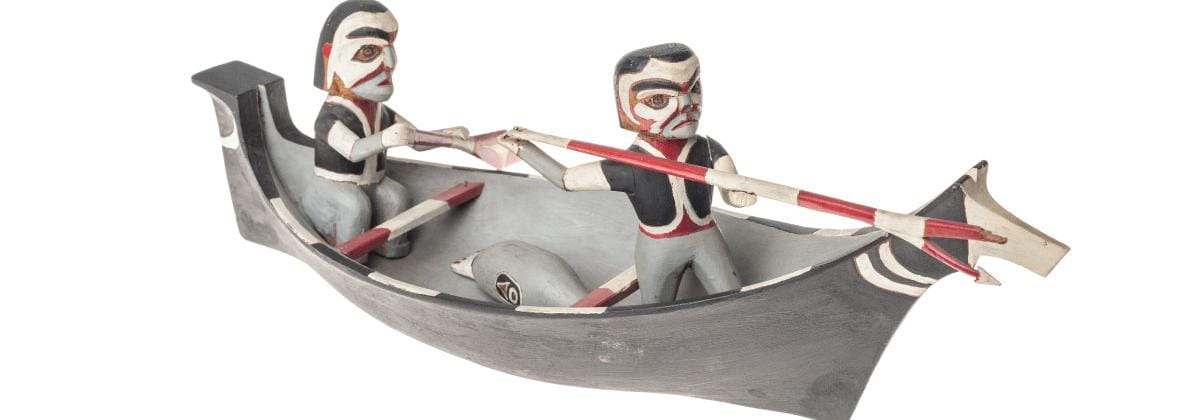
Modernization
Learn more about government’s intention to modernize the museum to protect our historic holdings and provide better access to our collections.

MORE INFORMATION | CONTACT | SEARCH
Ceremonial and utilitarian objects, tools and regalia for traditional use and the tourist market, typical examples and exceptional masterworks, objects that were old when they were collected and new works of art in a variety of media—all are in our exceptional ethnology collection of over 14,000 objects.
More than 65,000 photographic images and films in a variety of historical and modern formats document the people, communities and ways of life of First Peoples from the 1850s, when photographs were first taken in British Columbia, to the present. Approximately 3,700 sound recordings made with First Nations people preserve their vocabularies, stories, songs, oratory, traditions and histories for future generations.
The Royal BC Museum is honoured to care for, and learn from, this extraordinary collection, ensuring that it is accessible to First Peoples, artists, researchers, scholars and the interested public.
Proud sponsor of the First Nations ethnology digitization project
MORE INFORMATION | CONTACT | SEARCH
The ethnographic photography collection documents First Nations people, communities and ways of life over more than a century, from the 1850s when the first photographs were taken in British Columbia to the present. It includes approximately 65,000 images in a variety of historical and modern formats: cartes de visites, stereographs, cabinet cards, Victoria cards, snapshots, post cards, large format photographs, lantern slides and 35 mm slides.
Field photographs made by photographers who accompanied tours of inspection by colonial and dominion officials—Frederick Dally in 1866, Richard Maynard in 1873-74, Oregon Hastings in 1879 and Edward Dossetter in 1881—and early studio and field photographs by commercial photographers in Victoria such as Carlo Gentile and Hannah Maynard form the basis of the early archival holdings. Documentary photographs made by anthropologists, scientists and artifact collectors including George M. Dawson, Harlan I. Smith, Franz Boas, Charles F. Newcombe, Samuel Barnett, Albert P. Niblack, George Emmons and Marius Barbeau are significant visual records of late 19th and early 20th century First Nations people and communities.
The Royal BC Museum also holds approximately 3,700 sound recordings made with First Nations people of vocabularies, stories, songs, oratory, traditions and histories in many First Nation languages, along with approximately 200 video tapes of potlatches and other ceremonies made with and for First Nations individuals. Some of the sound recordings and video tapes can be accessed by appointment; others that document family histories and ceremonies can be accessed only with the permission of the rights holder of the hereditary privileges.
MORE INFORMATION | CONTACT | SEARCH
With nearly 225,000 catalogued artifacts, the Royal BC Museum holds the largest collection of British Columbia First Nations archaeological materials in the world. Collected since 1886, these artifacts represent up to 10,000 years of history. While the collection includes objects from Euro-American, European and Asian manufacture, 99 per cent are related to First Nations cultures.
The collection includes stone, bone and shell artifacts as well as other smaller categories such as wood, minerals and metals. There are also hundreds of cloth petroglyph rubbings and approximately 350 linear feet of associated excavation and survey materials in the form of artifact catalogue records, archaeological site records, field records, maps and research data. Thousands of boxes of non-artifactual material are stored at an off-site warehouse, including animal bone and shell samples, charcoal samples for radio-carbon dating, and various types of matrix and soil column samples from archaeological excavations.
The Royal BC Museum’s unique archaeology collections are an invaluable resource that continues to facilitate academic research and public programming, broadening and evolving our understanding of First Nations cultures in British Columbia.
MORE INFORMATION | CONTACT | SEARCH
The BC Archives holds a significant collection of records documenting First Nations communities since from first contact to the modern era. The records document a horizon of experiences from birth to death captured in textual records, photographs, sound recordings and cartographic material. As a government institution, the predominant volume of indigenous records in the BC Archives originates from relationships of sovereignty and status.
In the colonial era (ca. 1790s–1870s), records of exploration, early settlement and trade predominate. Examples include colonial correspondence (GR-1372); Douglas Treaties (MS-0772); J.R. Anderson fonds (Joint Indian Land Commissioner, PR-1057); and Colonial Land and Works Department (GR-2900).
Following BC's union with Canada, records of First Nations communities became encapsulated in government relationships. Ottawa acquired responsibility for the welfare of First Nations communities. The BC Archives holds the BC-related Ministry of Indian Affairs records known as RG-10. Indigenous land title was addressed in a series of government land commissions: the Joint Indian Reserve Commission (PR-2107, GR-0494), individual commissions (GR-933) and the McKenna-McBride Commission (GR-1303).
Records of First Nations activism and resistance, culture and identity became notable in the early 20th century. Records of indigenous advocacy are found in modern court records and First Nations Band Council files. The post-war world cast new light on the rights of humankind at the same time as cultural anthropology highlighted the values of indigenous cultures. By the 1960s there was a kind of renaissance in First Nations arts and culture captured in records such as local publications, cultural centres, graphic arts and displays.
The BC Archives recognizes that a complex new palette of sovereignty and status now colours the relationship between First Nations communities and the Royal BC Museum & Archives. Many First Nations communities understand the value of safeguarding their own community memory while recognizing the mutual benefits of sharing the records of Indigenous culture and identity with the people of BC through the museum and archives.